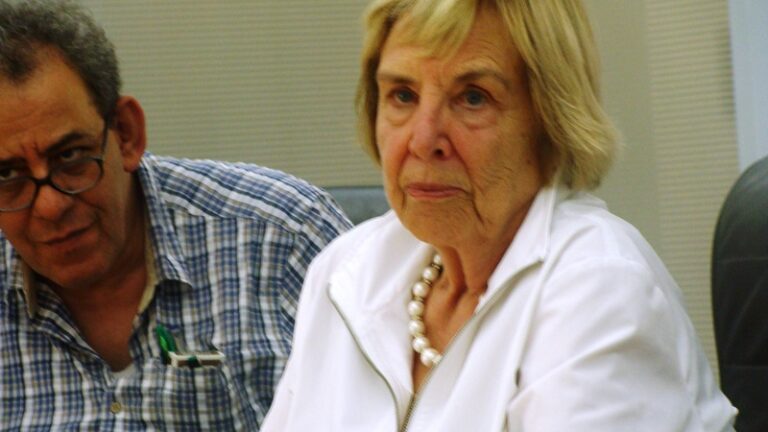Dialogue Series, Race & Society, Regional Studies
Barbara Stowasser Lectures on Concepts of Time in Islam

Barbara Stowasser, Director of the Center for Contemporary Arab Studies at Georgetown University, was invited to Doha to deliver aFocused Discussion on the subject of “Time Sticks” and concepts of time in Islam, to Georgetown faculty and staff.
Stowasser began the lecture by noting that “time is essential to the very structure of Muslim communal life. Time of ritual and worship of Muslim obligation are regulated according to celestial events – both lunar and solar.” She studied how the hours of the five daily prayers of Sunni Islam are controlled by the movement of the sun as well as its absence, and how these rituals have been reconfigured in today’s globalized world of regimented time-keeping. The Islamic calendar, she argued, has been instrumental in holding the Islamic world together over geographic distances and over many centuries.
In order to calculate prayer times in the pre-modern era, it was common to use “time sticks.” These, Stowasser said, are simple astronomical technologies that use shadow-length to measure daylight hours. They were part of religious knowledge and practice in all pre-modern societies, including that of the ancient Egyptians, the Babylonians, the Chinese, the Greeks, and the Romans. Unfortunately, she said, very few of these have been preserved in the Muslim world, but are prominently described in the literature.
Stowasser explained the difference between the notion of “seasonal time” that was used in the past and our modern conception of “abstract time.” In a world where the day is divided into abstract, standardized, and equal hours, “the five Islamic ritual prayers endow the day with a specific pulse that remains a vital sign of time perception in Muslim societies,” as these prayers are pegged to the older tradition of seasonal time and unequal hours. For millennia, other than those who resided on the equator, Stowasser argued, human patterns of living and working were organized around local astronomical time that differed along shorter and longer hours of daylight throughout the year.
Examining prayer times and standardization problems that arise as a result of geographical latitudes, Stowasser argued that they vary in length depending on their position between the equator and poles. Since “Islamic prayer times depend on terrestrial latitudes, this requires that prayer times should be defined in terms of shadow increase, not shadow length, which varies according to degree of latitude,” she said. Thus, shadow length in Mecca and Medina would not correspond with shadow lengths in other latitudes. “In the classical hadith, the historical and the normative are intertwined,” said Stowasser, and so, over time, the five daily prayers were negotiated and then established.
Surveying different historical periods, Stowasser said that in the Islamic world, the beginning of a new day started at dusk, and so was in keeping with the mechanisms of the lunar calendar. With the advent of the mechanical clock in the fourteenth century, time gradually became standardized across the nations. In the modern era, in order to coordinate regional time for the establishment of railroad and telegraph systems, longitudinal calculation was required to organize different time zones separated by geographic distances. “Technological progress has meant chronographic and calendrical standardization that eventually took on global validity. The Islamic prayer times are now regionally computed, often by electronic means,” Stowasser said. Moreover, “technology has also created the concept of linear time; a relatively recent Western invention that is replacing or is poised to replace the multiple subjective and situation specific times of the past […] The new form of clock-based time is producing a new form of global psychology where time equals punctuality, efficiency, and economic rationality.”
In conclusion, Stowasser said that “by way of early conquest and expansion, the Islamic realm fell heir to several much older civilizations that had long traditions of scholarship in the theoretical and applied sciences. From an early date, the science tradition was integrated into an Islamic world view,” said Stowasser. Currently, we are faced with Eurocentric and Western-enlightened critiques that claim pre-Islamic civilizations were profoundly mistrusted by an ever stricter Islamic orthodoxy. She argued, however, that the pre-modern Islamic texts do not support this critique. “In the Islamic world today, the Western calendar provides a global point of reference, even where the Islamic year reigns supreme,” but, she said, in some areas of Yemen and Saudi Arabia, “the old system has survived and created a system of double time-keeping.”
During the past several decades, Stowasser’s research and publications have focused on Islam and gender, which has made her one of the early pioneers on this topic in the West. Among her publications is Women in the Qur’an, Traditions and Interpretation and she co-edited and contributed to the volume Islamic Law and the Challenges of Modernity. At Georgetown, Stowasser developed and taught all the graduate courses on Qur’anic tafsirand introduced the study of Islam and gender into the curriculum. Stowasser was the former Chair of the Department of Arabic (now the Department of Arabic and Islamic Studies, in Georgetown College).
Article by Suzi Mirgani, CIRS Publications Coordinator